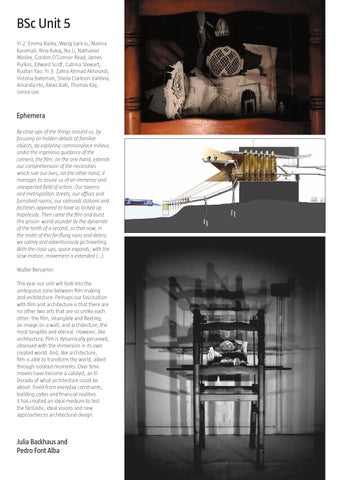BSc Unit 5 Yr 2: Emma Bailey, Weng Sam Iu, Marina Karamali, Rina Kukaj, Na Li, Nathaniel Mosley, Gordon O’Connor Read, James Purkiss, Edward Scott, Catrina Stewart, Ruofan Yao. Yr 3: Zahra Ahmad Akhoundi, Victoria Bateman, Sheila Clarkson Valdivia, Amanda Ho, Alexis Kalli, Thomas Kay, Janice Lee.
Ephemera By close-ups of the things around us, by focusing on hidden details of familiar objects, by exploring commonplace milieus under the ingenious guidance of the camera, the film, on the one hand, extends our comprehension of the necessities which rule our lives; on the other hand, it manages to assure us of an immense and unexpected field of action. Our taverns and metropolitan streets, our offices and furnished rooms, our railroads stations and factories appeared to have us locked up hopelessly. Then came the film and burst this prison- world asunder by the dynamite of the tenth of a second, so that now, in the midst of this far-flung ruins and debris, we calmly and adventurously go travelling. With the close ups, space expands, with the slow motion, movement is extended (‌). Walter Benjamin This year our unit will look into the ambiguous zone between film making and architecture. Perhaps our fascination with film and architecture is that there are no other two arts that are so unlike each other: the film, intangible and fleeting, an image on a wall; and architecture, the most tangible and eternal. However, like architecture, film is dynamically perceived, obsessed with the immersion in its own created world. And, like architecture, film is able to transform the world, albeit through isolated moments. Over time movies have become a catalyst, an El Dorado of what architecture could be about: freed from everyday constraints, building codes and financial realities it has created an ideal medium to test the fantastic, ideal visions and new approaches to architectural design.
Julia Backhaus and Pedro Font Alba
